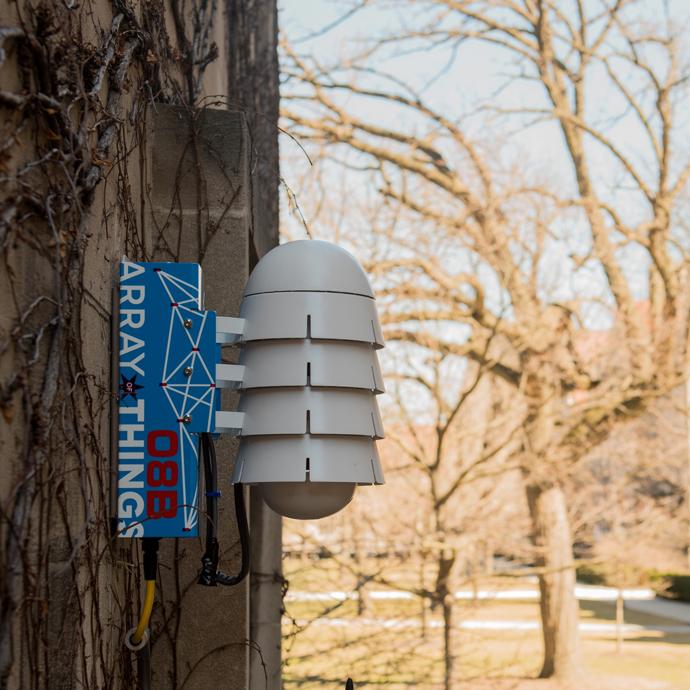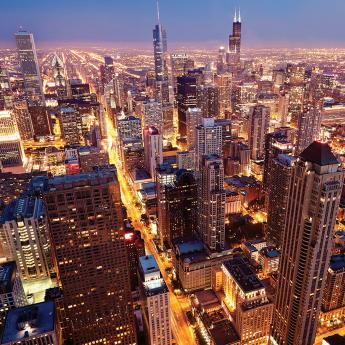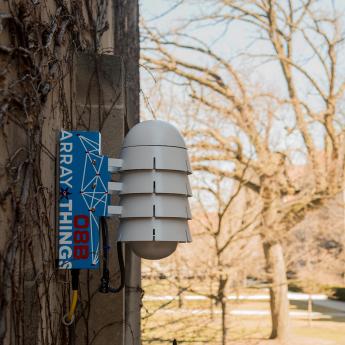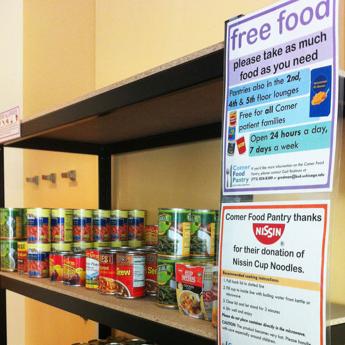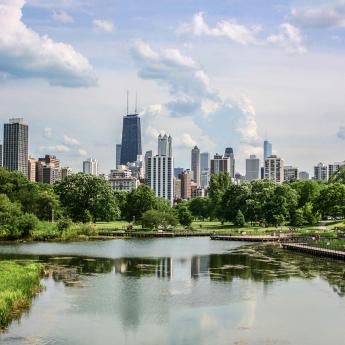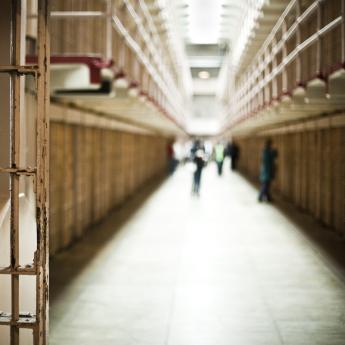Show Notes
Imagine a health monitor for the city, but instead of measuring heart rate or daily steps, this device measures everything from air quality to vehicle traffic.
The idea may sound like science fiction, but it’s becoming a reality for cities like Chicago through the Array of Things project, a collaborative effort between scientists, universities, local government and community members to collect real-time data on the city.
Transcript:
Charlie Catlett: What I’m trying to do is position a city like Chicago or another city to use technology, to improve how it works, to improve the experience of living and working in the city or visiting the city.
Andrew Bauld: This is Charlie Catlett. He’s the Director of the Urban Center for Computation and Data at the University of Chicago and Argonne National Laboratory. Charlie leads a project called Array of Things, and his goal is to install a network of real time data collection sensors to create a health monitor for the city. But this isn’t just some new trendy piece of tech.
Charlie Catlett: I’m not super fond of the term smart city, partly because it tends to be thrown around in context where we can solve the challenges that cities have with technology alone.
Andrew Bauld: Charlie is bringing together scientists, universities, local government, and communities to make Chicago, and eventually cities around the world, healthier and more efficient places to live. From the University of Chicago, this is Knowledge Applied, a podcast where we go inside the research reshaping everyday life. I’m Andrew Bauld.
Andrew Bauld: Imagine a busy intersection in downtown Chicago. People, bikes, cars rush by, and it seems like nearly every minute there’s a chance of an accident. These near misses would mostly have gone unnoticed before, but now, that information can be captured, analyzed, and sent to a variety of people, from engineers to urban planners, who can work to change traffic flow and make that intersection safer for everyone. It may sound like science fiction, but it’s becoming reality for cities like Chicago, thanks to the Array of Things project, which began from a simple premise.
Charlie Catlett: We said, “Well, we can’t afford million dollar stations to put 100 of them in the city, and you can get limited data from these do it yourself projects, where people spend $50 and build a sensor and put it in their home.” But could we come somewhere in between there and build a device that could produce reliable scientific data, and then put those across the city, not just uniformly, but strategically placed, so that we could measure the city?
Andrew Bauld: It’s a little like a Fitbit, but instead of measuring steps or heart rate, the devices measure things like air quality and vehicle traffic. Charlie was already working with the city of Chicago on another project, helping optimize food safety inspection, when he recognized the real difference data could make to the life of the city.
Charlie Catlett: So why we’re doing the Array of Things, it’s the same reason we’re doing everything else we’re doing, and that is, we talked to people in the city of Chicago to understand what their challenges are. And we found from talking to them and from our own work, that there’s a lot of data that’s missing that should be able to be measured, and that requires data analytics, it requires data integration infrastructure, and it requires not just putting sensors out, but it requires a measurement strategy that takes advantage of what’s out there already, and then augments it. And we’ve been augmenting it was the Array of Things.
Andrew Bauld: The Array of Things are being designed at Argonne, the country’s first national laboratory, born out of the work of the Manhattan Project, and now run by the University of Chicago and the US Department of Energy’s Office of Science. The devices themselves look like shiny blue tool boxes standing on end with a stack of white bowls attached, but don’t let the whimsical design fool you. In 2015, the National Science Foundation gave the Array of Things project a $3.1 million grant to support its development. Charlie and I visited what he calls the tinker lab to take a look at some of the sophisticated sensors that make up a node.
Charlie Catlett: This has got multiple temperature and humidity sensors on it. It’s got barometric pressure, it’s got vibration. It has magnetic field. It’s got the environmental sensors that we want. There’s another board that we built that does light intensity. It’s pointed straight up. It also gives us an infrared and ultraviolet, and it also has a pole in the board so that we can insert our five mega pixel camera to look straight up at the sky. So that gives us an ability to look at things like cloud cover, or even to look at air quality, as well as to have a good understanding of what the solar intensity is, which in turn will affect how you heat or cool a building.
Andrew Bauld: Next, we visited the nursery, the lab space where the devices are tested before they get shipped out to the city.
Charlie Catlett: There’s a umbilical cord, if you will, between the white sensor shield and the box that goes against the pole. And it’s through that cord that all the sensor data to the computers inside the box. That’s where the images get analyzed and then discarded. That’s where the security of the device is handled, the communications. If there’s a network outage or if something happens to the modem, these will continue to operate, collecting their data, and they’ll just queue it up. We’ve probably got space on here that we could go multiple months saving the sensor data.
Andrew Bauld: The information collected will eventually make its way to a database, where it’ll be free for public use. That data will be beneficial for a variety of constituents, including urban planners, city government officials, and local businesses.
Charlie Catlett: When I talk to people in the city of Chicago and other cities, they’re looking for a early alert system for the common things that they need to take care of, like flooding or a power outage at an intersection. Not everyone calls 311 or 911. You’d think that a flooded corner or intersection would generate calls to the city, but it doesn’t always, because there’s an assumption that somebody else is already going to call. So for the city to have knowledge in near real time that water is rising at an intersection and to do something about it, like go and clear branches that might have clogged the sewer or what have you, that’s the first place the city I think, is looking for value.
Andrew Bauld: Despite the advantages, perhaps it won’t be surprising to hear that some people have concerns with the idea of 24/7 sensors going up throughout the city. But Charlie assures that people’s privacy will be protected, thanks to one of the unique aspects of the Array of Things devices, which is to analyze photos within each unit, quantify that information, and then destroy the image.
Charlie Catlett: That allows us to have a much more precise privacy policy than a traditional camera network that streams video or images back to some location, where at some point in the future policies could change, so you really don’t know what’s going to happen with those images. With our policy, because we analyze the images inside the box and then discard them, we can say, “This is all that’s going to be done with those images. And after that, the images are going to go away.”
Andrew Bauld: The sensors began going up in the summer of 2016 in about a dozen locations across Chicago. Charlie is aiming to have 500 nodes installed over the next few years. The decision of where the devices are installed is a rigorous process.
Charlie Catlett: So the selection of sites, we require three things. Number one is that the residents of that part of the city are interested in something that we can measure. They may be interested in traffic safety. They may be interested in air quality. They may be interested in lake effect on weather. Second is that we want to make sure that there’s a science community or team out there that’s interested in looking at the data and providing some insight into that particular issue. And the third is that there’s somebody from local government that is also wanting to see more data and insight about that.
Andrew Bauld: One of the earliest sensors went up in Pilsen, a neighborhood in Chicago that for decades has been dealing with serious environmental issues.
Charlie Catlett: That southwest part of the city, there’s just a history of air quality issues related to the Superfund site or to factories or transportation or other things. And that’s something that we were aware of. Also, that’s a part of the city that has the Stevenson Expressway going through. We had our first public meeting in Pilsen, in the public library there, so that we could interact with people that live there and say, “Hey, we want to measure air quality here. We really want to capture air quality. Do we have the right distribution? Do we need them every kilometer or every half kilometer or every block?” And where we want to look at the impact of the Stevenson Expressway, which is six lanes of highway, how far away from the Stevenson Expressway do we start to see the impact of traffic? We’re looking forward to getting some of that air quality in the next few months.
Andrew Bauld: In addition to the spread of the devices throughout the city, word of the program is growing beyond Chicago. Charlie has received demand from all over the world, wanting to take part.
Charlie Catlett: We’ve now had over 100 cities or universities contact us wanting to do pilot projects. So there are a half dozen or so of those that we’re going to do pilots. We’ve already got a couple of units mounted in Chattanooga and Denver, one in Seattle, Portland, and then we’ll have Stanford, Chapel Hill, North Carolina with UNC, and then next year, another dozen or so should be ready. And most of the ones next year, or as many of the ones next year, will be overseas as well, China, India, Japan, Denmark, UK.
Andrew Bauld: Eventually Charlie envisions hundreds of the devices sharing data from across the globe.
Charlie Catlett: My ultimate, or at least near term goal, is I think it’s realistic for us to think about 100 cities around the globe with 100 of these devices. If you could imagine that type of infrastructure pulling data in about air quality and the movement of traffic and pedestrians and weather and sound from 100 cities around the globe of every size and geography and climate, that would make for a really, really valuable set of data. If we can do that and then pull that data into one place, then there are a lot of urban scientists and policy makers who I think would make very good use of that data.
Andrew Bauld: Until then, Charlie and the Array of Things project is working at the local level, with Chicago high school students, helping train the next generation of data side scientists.
Charlie Catlett: We partnered with Lane Tech High School to put a curriculum in place that we’ve now taught two years in a row at Lane Tech to train these students to think about a science or a policy question that they might have. See if that’s a question that could be answered by measurement and data, and then build a measurement device, sensor unit, deploy it, collect data and analyze the data. We did 150 students last year and 150 students this year, and we’ll do another 150 next year.
Andrew Bauld: As sensor technology continues to develop, the Array of Things devices will become even more advanced, helping scientists and government official capture a more expansive and nuanced portrait of cities. And while the devices probably won’t look much different on the outside, on the inside new sensors could measure a wider range of environmental factors from methane to allergens and beyond.
Charlie Catlett: We’re imagining and starting to do the fundamental research, or applied research really, so that in a year let’s say, we’ll be able to start looking at a near miss of a car accident saying, “Hey, six times a car had to stop suddenly because there was a pedestrian that was in front of them,” or, “Four times today, we saw a car have to swerve around some bicycle,” or something like that. So, the biggest changes in the new versions will happen on the inside, and they’ll be of the form of more and better sensors and more sophisticated ways to analyze the images.
Andrew Bauld: Knowledge Applied is a production of the University of Chicago. To learn more, visit us at news.uchicago.edu. You can listen to this episode and all of our episodes, iTunes, Stitcher, and wherever else you get your podcasts. Stay tuned for our next series, coming this spring. It’s called Big Brains, where you’ll hear interviews with transformative thinkers, changing the way you see the world. Thanks for listening.
Episode List
The Magic of Cities, with Luis Bettencourt (Ep. 5)
Luis Bettencourt, Pritzker Director of the Mansueto Institute for Urban Innovation, discusses his research on complex systems and how he’s combining science and policy and using data to capture “the magic of cities for the common good.”
Making a Smarter City, with Charlie Catlett (Ep. 4)
Charlie Catlett, director of the Urban Center for Computation and Data at UChicago and Argonne, is leading an effort called the Array of Things that aims to install 500 sensor nodes around Chicago and eventually setup a network around the world “to improve living and working in the city.”
Hunger in the Hospital, with Stacy Lindau (Ep. 3)
Physician-scholar Stacy Lindau shares how she decided to address what she called a “real humanitarian need” by leading a Chicago-area program to help combat hunger called Feed1st. The food pantries benefit families and hospital staff, and the program provides critical data for future medical study.
The Psychology of Trees, with Marc Berman (Ep. 2)
UChicago environmental psychologist Marc Berman shows that adding trees to a city can have a significant impact on a person’s health and happiness. His findings have shown that even just looking at pictures of nature or hearing nature sounds can have positive cognitive effects.
Smart Decarceration, with Matt Epperson (Ep. 1)
SSA Assoc. Prof. Matt Epperson discusses the history of mass incarceration, and the social and political changes that have occurred over the last decade that may make this the ideal time to begin shrinking the U.S. prison population.

